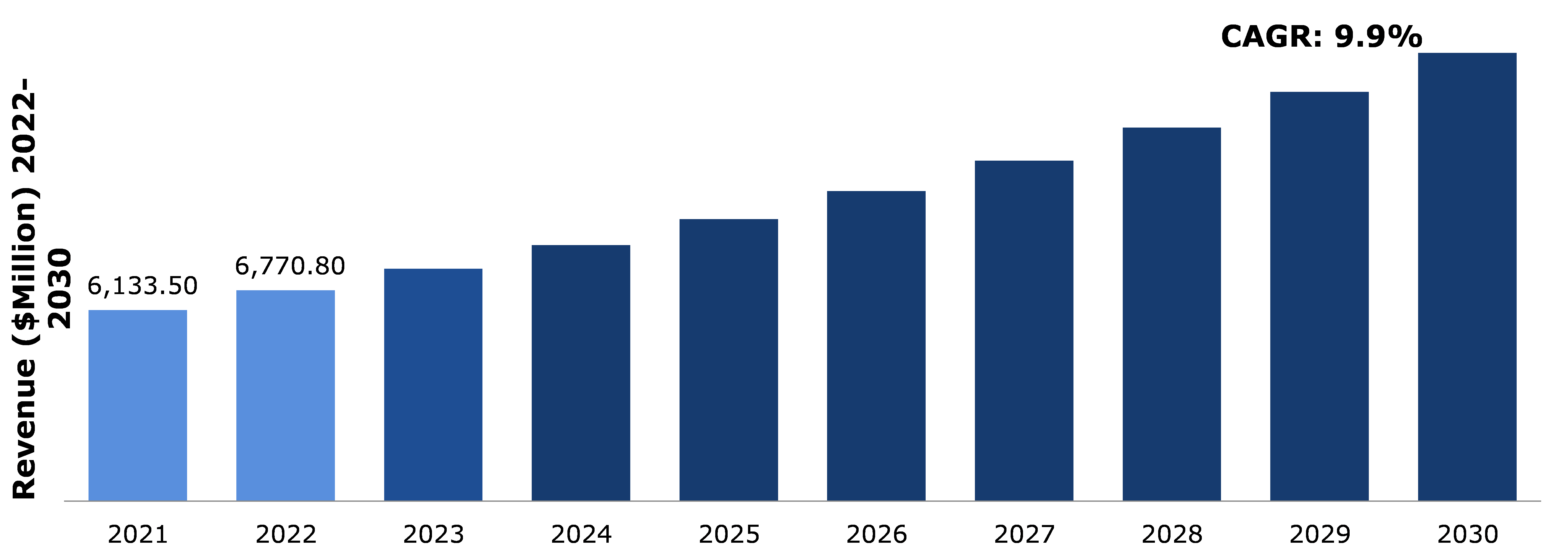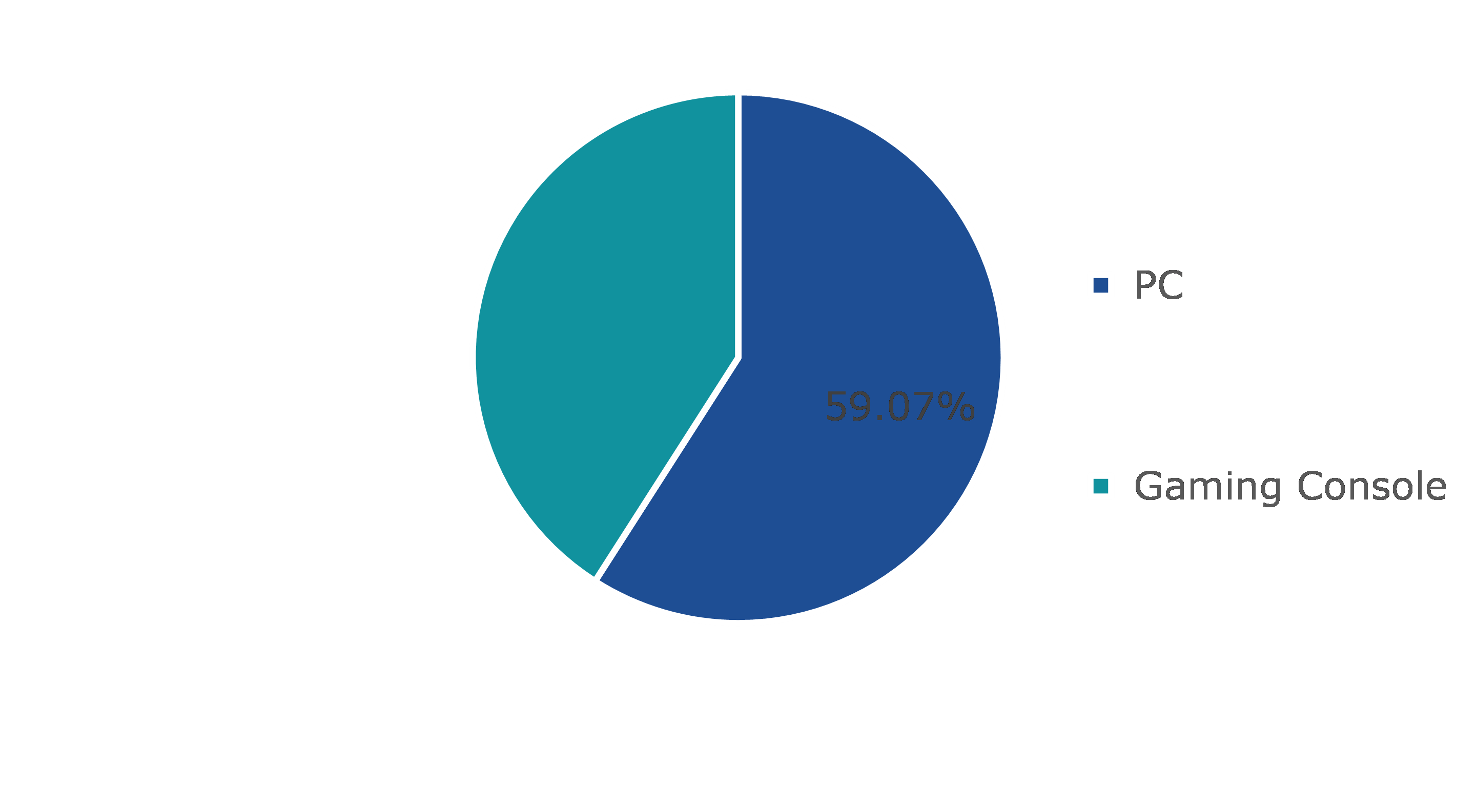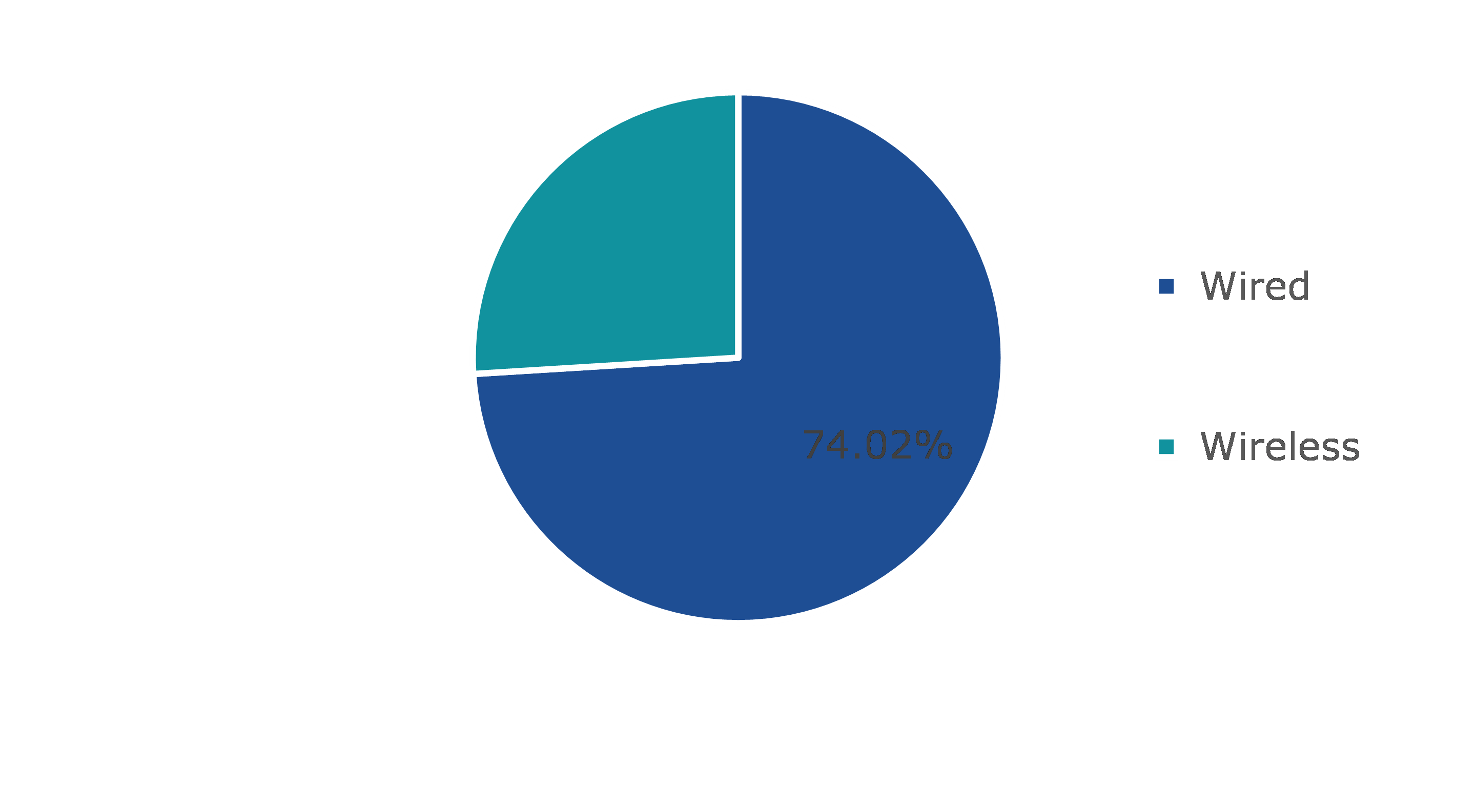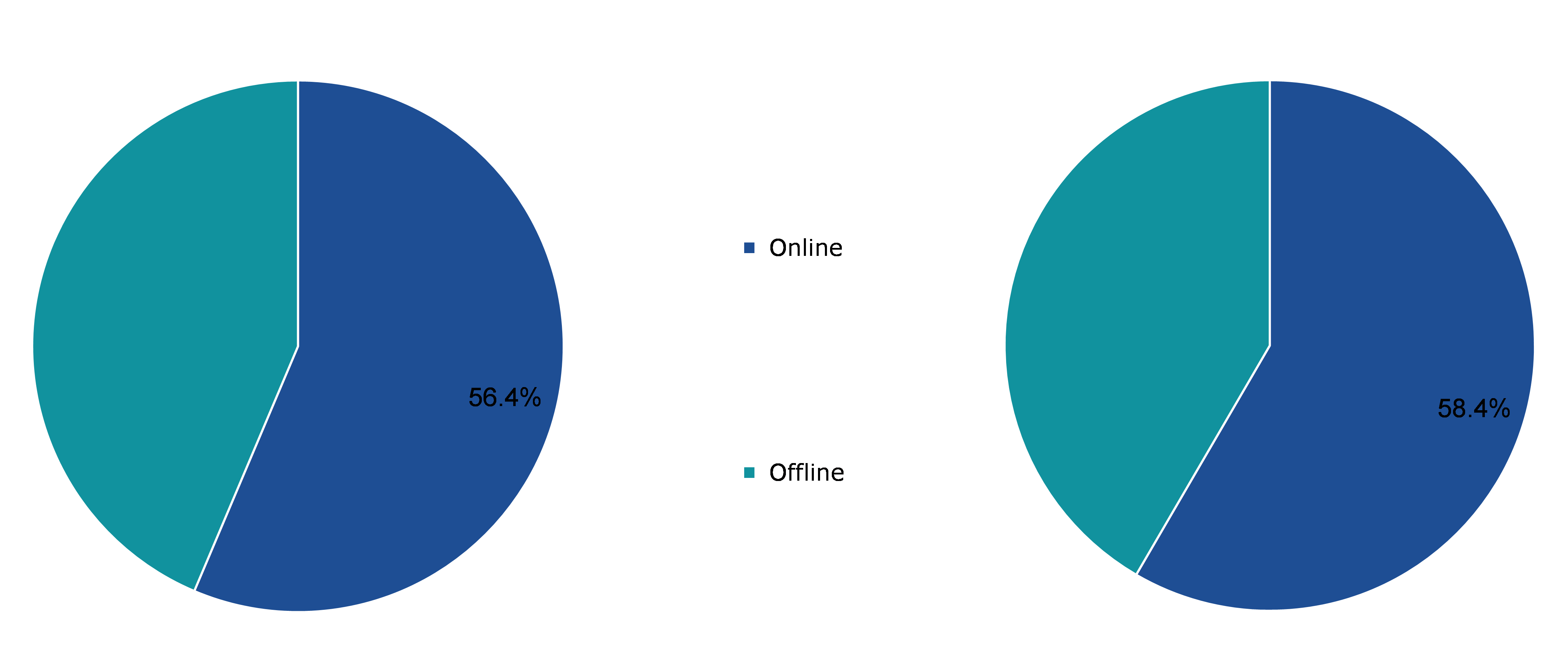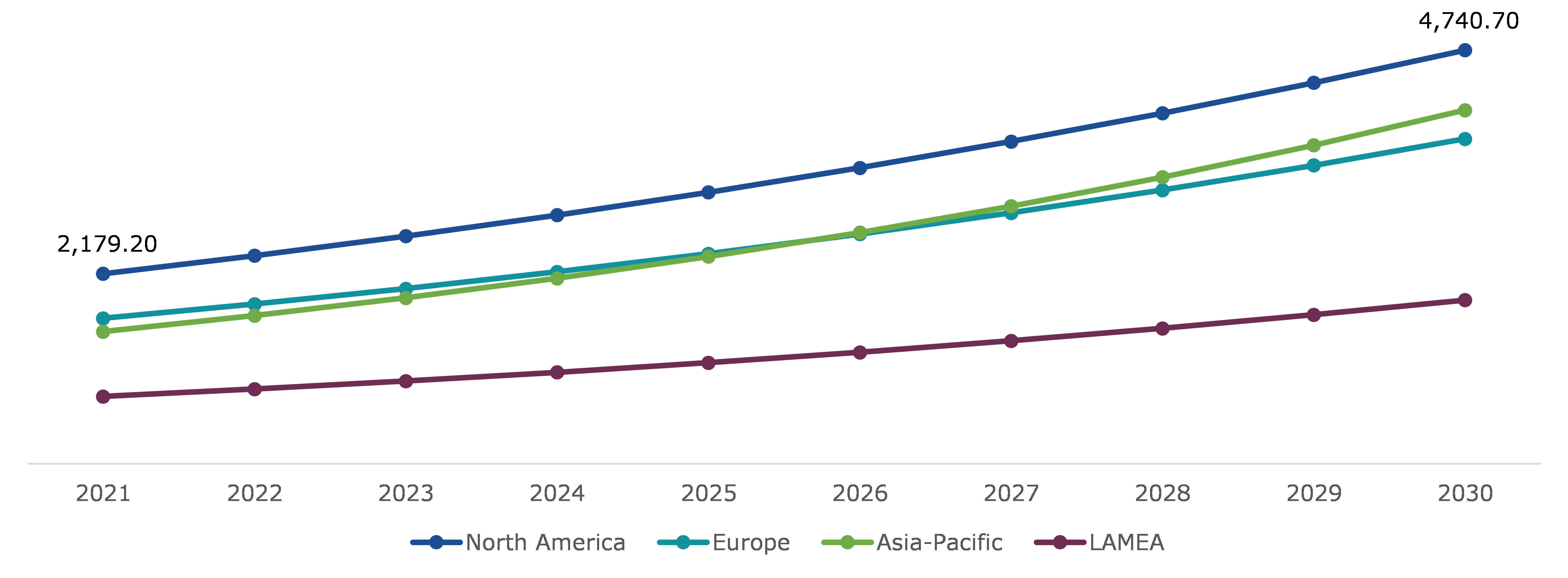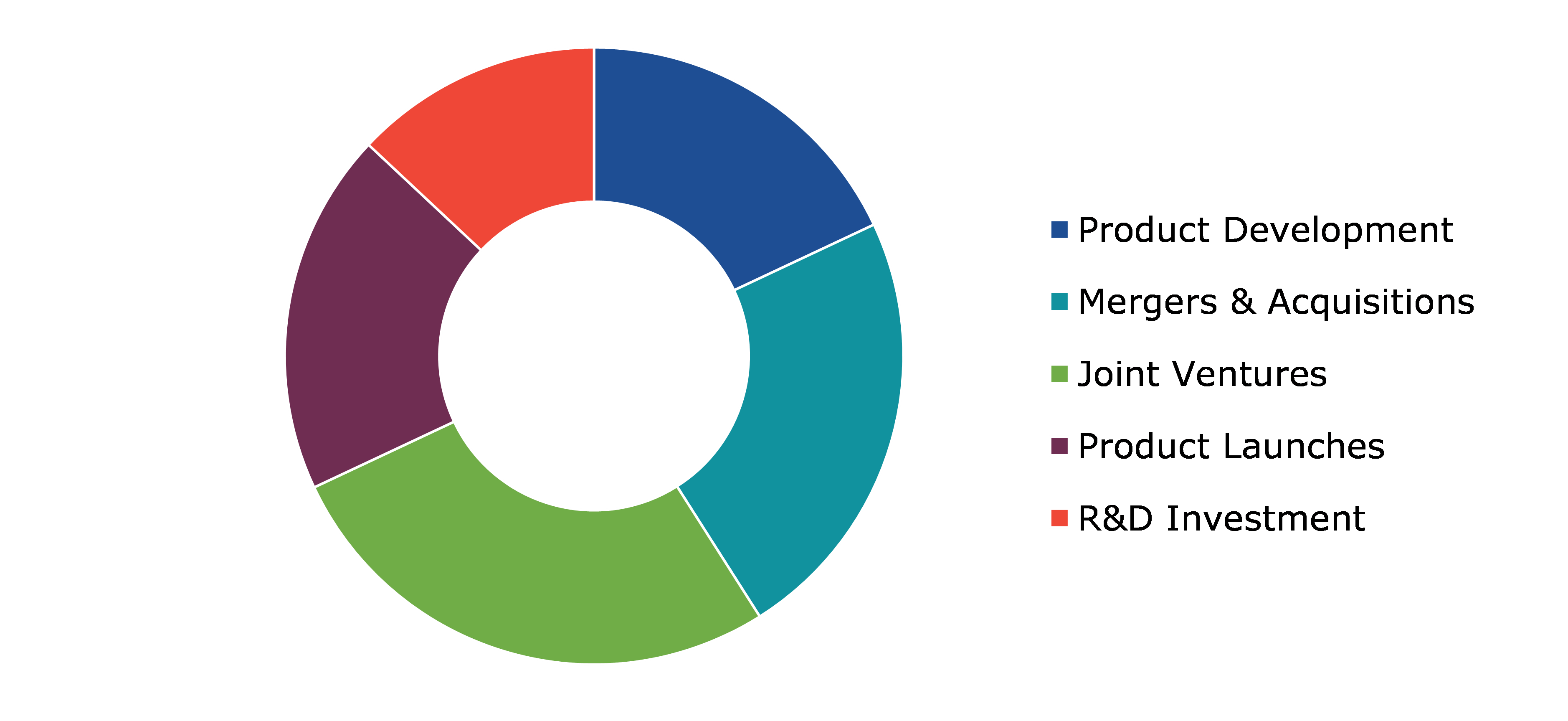Gaming Peripherals Market Report
RA08523
Gaming Peripherals Market by Component (Headsets, Keyboard, Controller, Mic, and Others), Device Type (PC and Gaming Console), Connectivity Type (Wired and Wireless), End-use (Online and Offline), and Regional Analysis (North America, Europe, Asia-Pacific, and LAMEA): Global Opportunity Analysis and Industry Forecast, 2022-2030
Gaming Peripherals Market Analysis
The global gaming peripherals market is estimated to be valued at $14,396.40 million by 2030, surging from $6,133.50 million in 2021, at a noteworthy CAGR of 9.9%.
Market Synopsis
The gaming peripherals market is expected to grow due to product advancements, acquisitions, and business expansion by key market players to increase the adoption of gaming peripherals for entertainment purpose.
However, the main impediment is cloud gaming, it enables consumers to play streamed games across devices, often without the need for expensive hardware.
According to the regional analysis of the market, the Asia-Pacific gaming peripherals market is anticipated to grow at a CAGR of 11.5%, by generating a revenue of $4,054.00 million during the review period.
Gaming Peripherals Overview
Gaming peripherals are input and output devices that are connected to a personal computer (PC) or laptop to provide users with a better gaming experience. Users can choose from a variety of peripherals, such as mic, headsets, controllers, and keyboards. Because video games provide an interactive gaming experience, they have gradually surpassed traditional board games in popularity. This has given the gaming industry a boost, particularly among the younger generation around the world. This has been aided further by the increasing global penetration of the internet and the introduction of gaming laptops and PCs.
COVID-19 Impact on Gaming Peripherals Market
The world is currently witnessing a pandemic on an unprecedented scale. The pandemic has impacted moderately on gaming peripheral market. The COVID-19 pandemic has had a significant impact on the global economy, causing a halt in manufacturing, production, and other operations of the peripherals. Also, slowdown in Chinese gaming peripherals production impacted the market. Moreover, companies such as Nintendo, a Japanese consumer electronic and video multinational company, witnessed a decrease in the production of switch component, used for making gaming peripherals. Also, Valve company faced the same production issues caused by COVID-19.
While many gaming peripherals manufacturers struggle to adapt to digital customer service and maintain demand until the crisis is over, digital-content-focused segments of the entertainment industry have found themselves better positioned to weather the change, and in some cases, are thriving. Additionally, millions of people around the world turn to digital entertainment as they remain indoors. The videogame industry, in particular, has boomed, with Steam recording the most concurrent users since the platform's inception and Verizon reporting a 75% increase in gaming traffic during peak hours. Moreover, the number of gamers across the globe has increased in past few years. These are some factors which are helping in the market growth.
Increased E-Sports Participation and an Increasing Number of Hard Core/Casual Gamers are Expected to Drive Growth in PC Gaming Peripherals.
The growing popularity of e-sports and increasing hard core or casual gamers are expected to drive growth in the PC gaming peripheral market during the forecast period. Hard core gamers are those who spend a significant amount of time playing video games and use advanced technology gaming peripherals. The introduction of e-sports and virtual gaming has increased the demand for gaming keyboards and gamepads, which improves users' gaming experiences. According to the Corsair Gaming Inc., an American computer peripherals and hardware company, there were an estimated 524 million PC gamers in 2019, including dedicated, competitive, and casual PC gamers. Around 94 million of these gamers spent more than $1,000 on gaming PC systems. Furthermore, committed, competitive, and casual gamers are estimated to have spent an average of $651, $179, and $14 on gaming PC gear in 2019. As a result, rising consumer demand for games has increased the demand for gaming consoles, peripheral device types, and other related products. Furthermore, the affordability of these peripheral device types, as well as the rise in youth populations, is major factor expected to drive market growth.
To know more about global gaming peripherals market drivers, get in touch with our analysts here.
High Cost of Gaming Peripherals is Expected to Hamper the Growth of the PC Gaming Peripherals Market over the Forecast Period
The high cost of gaming peripheral device types like gaming mouse, keyboards, and joysticks is expected to stymie the growth of the gaming peripheral market. Due to the lack of advanced gaming peripherals such as DPI mic and anti-ghost switches, gamers were forced to spend more money on peripherals. This, in turn, is expected to stifle demand for PC gaming peripherals, limiting market growth over the forecast period.
Growing Demand for Augmented Reality and Virtual Reality is Expected to Create Lucrative Growth Opportunities for Market Players
The growing number of hard-core or casual gamers and the increasing popularity of e-sports are among the key factors driving the gaming peripherals market. E-sports and virtual games have resulted in the development of specialized gaming keyboards and gamepads that can be customized and provide the user with better ergonomics. Consumers are increasingly demanding immersive and realistic gaming experiences, resulting in a demand for peripheral device types, high-quality gaming consoles, and so on. Furthermore, as the young working population has grown, so has the affordability of gaming peripheral device types. Furthermore, factors such as the introduction of augmented reality, virtual reality, high-definition displays, and so on are expected to catalyze the market's growth. The aforementioned factors demonstrate that the demand for gaming peripherals technology in the automotive sector is increasing at an exponential rate, which may create massive opportunities in the coming years. The growing popularity of e-sports and gaming tournaments such as the PUBG Global Championship, League of Legends World Championship, and the CWL (Call of Duty World League) is driving demand for advanced peripherals that support gamers improve their gaming skills.
To know more about global gaming peripherals market opportunities, get in touch with our analysts here.
Global Gaming Peripherals Market, by Component
Based on component, the market has been divided into headsets, keyboard, controller, mic, and others. Headsets sub-segment accounted for the highest revenue share in 2021 and is predicted to show the fastest growth during the forecast period.
Global Gaming Peripherals Market Share, By Component, 2021
Source: Research Dive Analysis
The headsets sub-segment is expected to have the largest market share, with revenue exceeding $4,602.70 million by 2030, up from $1,893.00 million in 2021.
A gaming headset is a device that includes headphones & microphones and is used by gamers while playing video games. These headsets are typically designed to block out external noises, add comfort to the gamer, facilitate in-game communication, and completely immerse a player in the world of gaming. Growing online gaming and rising awareness of advanced multi-platform gaming headsets are driving the growth of the gaming headset in gaming peripherals market. Furthermore, the growing number of gaming connectivity around the world, as well as the trend of using gaming-specific headsets while gaming is driving the growth of the gaming headsets market.
Global Gaming Peripherals Market, by Device Type
Based on device type, the analysis has been divided into PC and gaming console. Out of these, PC sub-segment is predicted to be the most dominant and gaming console sub-segment is anticipated to show the fastest growth during the forecast period.
Global Gaming Peripherals Market Share, By Device Type, 2021
Source: Research Dive Analysis
The PC sub-segment of the global gaming peripherals market is anticipated to have a dominant market share and surpass $8,345.40 million by 2030, with an increase from $3,622.80 million in 2021. PC Gaming peripherals are hardware devices used in conjunction with games, such as gaming mouse & keyboard, headsets, surfaces, and controllers. Various features such as facial recognition and gesture-based gaming, coupled with high-quality graphics and improved playing experience are expected to drive the demand for the PC sub-segment. Based on the availability of graphics and computing, vendors prioritize mid-level gaming PCs for revenue generation. Gaming PCs are typically custom-built with specifications such as a high-end processor, graphics processing unit (GPU), overclocked processor, and liquid cooling, among others, in order to pique the interest and enthusiasm of gamers.
Global Gaming Peripherals Market, by Connectivity Type
Based on connectivity type, the analysis has been divided it into wired and wireless. Among these, wired is predicted to be the most dominant sub-segment and wireless sub-segment is anticipated to have the fastest growth during the forecast period.
Global Gaming Peripherals Market Share, By Connectivity Type, 2021
Source: Research Dive Analysis
The wireless sub-segment is predicted to be the fastest growing sub-segment of the gaming peripherals market and garner a market share of $3,904.20 million by 2030, up from $1,593.40 million in 2021. When it came to competitive gaming, wireless peripherals used to lag far behind their wired counterparts. The continuous development by leading players such as Corsair, Razor, Logitech, and others, to provide better battery life and better functionality to the peripherals is one of the major reasons which is expected to boost the demand for the wireless peripherals in the forecast period. For instance, in July 2020, Logitech, a leading peripheral manufacturer, introduced the G502 Lightspeed wireless gaming mouse. PowerPlay, Logitech's proprietary wireless charging technology, is another new feature included in the Logitech G502 Lightspeed. The growing popularity of video games as a result of easy access to high internet speed and compatible hardware is also expected to boost gaming peripherals market demand. Furthermore, as gaming subscriptions grow, major manufacturers such as Logitech and Razer are introducing technologically advanced devices, such as Razer gaming keyboard & mouse, and others to meet application-specific requirements.
Global Gaming Peripherals Market, by End-use
Based on end-use, the analysis has been divided into online and offline. Out of these, online sub-segment is predicted to be the most dominant and show the fastest growth during the forecast period.
Global Gaming Peripherals Market Share, by End-use, 2021 & 2030
Source: Research Dive Analysis
The online sub-segment is predicted to be the fastest growing sub-segment of the gaming peripherals market and garner a market share of $8,407.90 million by 2030, up from $3,458.10 million in 2021. The online sub-segment is expected to grow at the fastest, owing to the growing popularity of online retailers such as Amazon, Flipkart, and eBay, as well as the increased use of smartphones and other similar devices. Furthermore, online portals offer all time availability & support, an extensive range of products to pick from, and substantial discounts on branded products. The majority of prominent companies also have their own websites, which contributes to the sub-segment's growth.
Global Gaming Peripherals Market, Regional Insights:
The gaming peripherals market was investigated across North America, Europe, Asia-Pacific, and LAMEA.
Global Gaming Peripherals Market Size, By Region, 2021-2030 ($Million)
Source: Research Dive Analysis
The Market for Gaming Peripherals in North America to be the Most Dominant
The North America gaming peripherals market accounted $2,179.2 million in 2021 and is projected to register a revenue of $4,740.70 million by 2030. One of the fastest-growing entertainment industries in the United States is the gaming industry. The region has also registered a number of online gaming tournaments that necessitates the use of cutting-edge technology. This has encouraged gamers to buy the most up-to-date gaming peripherals, contributing to the growth of gaming accessories in the North America market. The market's growth is influenced by the extensive availability of internet services and smartphones, even among teenagers. Furthermore, due to the region's high disposable income, spending on online gaming is significantly high in North America.
Competitive Scenario in the Global Gaming Peripherals Market
Product advancements, innovations, and business expansion are common strategies followed by major market players.
Source: Research Dive Analysis
Some of the leading gaming peripherals market players are Logitech, Ducky, Corsair, SteelSeries, Razer, HyperX, ZOWIE (BenQ), Mad Catz, Cooler Master Technology Inc., and Plantronics Inc.
| Aspect | Particulars |
| Historical Market Estimations | 2020-2021 |
| Base Year for Market Estimation | 2021 |
| Forecast Timeline for Market Projection | 2022-2030 |
| Geographical Scope | North America, Europe, Asia-Pacific, LAMEA |
| Segmentation by Component |
|
| Segmentation by Device Type |
|
| Segmentation by Connectivity Type |
|
| End-use |
|
| Key Companies Profiled |
|
Q1. What is the size of the global gaming peripherals market?
A. The size of the global gaming peripherals market was over $6,133.50 million in 2021 and is projected to reach $14,396.40 million by 2030.
Q2. Which are the major companies in the gaming peripherals market?
A. Logitech, Ducky, Corsair, and Razer are some of the major companies operating in the global gaming peripherals market.
Q3. Which region, among others, possesses greater investment opportunities in the near future?
A. The Asia-Pacific region possesses great investment opportunities for investors to witness the most promising growth in the future.
Q4. What will be the growth rate of the Asia-Pacific gaming peripherals market?
A. The growth rate of the Asia-Pacific gaming peripherals market is 11.5%.
Q5. What are the strategies opted by the leading players in this market?
A. Product innovations, technological advancements, and business expansions are the key strategies opted by the operating companies in this market.
Q6. Which companies are investing more on R&D practices?
A. Logitech, Ducky, Corsair, Razer, and Plantronics Inc. companies are investing more on R&D practices.
Q7. Which peripherals are most important in gaming?
A. Keyboard, mouse, headset, and others are the most important gaming peripherals.
Q8. What is the biggest gaming peripherals company?
A. The most popular gaming peripheral brands are, SteelSeries, Logitech G, Razer, and Corsair.
1.Research Methodology
1.1.Desk Research
1.2.Real time insights and validation
1.3.Forecast model
1.4.Assumptions and forecast parameters
1.5.Market size estimation
1.5.1.Top-down approach
1.5.2.Bottom-up approach
2.Report Scope
2.1.Market definition
2.2.Key objectives of the study
2.3.Report overview
2.4.Market segmentation
2.5.Overview of the impact of COVID-19 on gaming peripherals market
3.Executive Summary
4.Market Overview
4.1.Introduction
4.2.Growth impact forces
4.2.1.Drivers
4.2.2.Restraints
4.2.3.Opportunities
4.3.Market value chain analysis
4.3.1.List of raw material suppliers
4.3.2.List of manufacturers
4.3.3.List of distributors
4.4.Innovation & sustainability matrices
4.4.1.Technology matrix
4.4.2.Regulatory matrix
4.5.Porter’s five forces analysis
4.5.1.Bargaining power of suppliers
4.5.2.Bargaining power of consumers
4.5.3.Threat of substitutes
4.5.4.Threat of new entrants
4.5.5.Competitive rivalry intensity
4.6.PESTLE analysis
4.6.1.Political
4.6.2.Economical
4.6.3.Social
4.6.4.Technological
4.6.5.Environmental
4.7.Impact of COVID-19 on gaming peripherals market
4.7.1.Pre-covid market scenario
4.7.2.Post-covid market scenario
5.Gaming Peripherals Market, by Component
5.1.Overview
5.1.1.Market size and forecast, by component
5.2.Headsets
5.2.1.Key market trends, growth factors, and opportunities
5.2.2.Market size and forecast, by region, 2022-2030
5.2.3.Market share analysis, by country 2022 & 2030
5.3.Keyboard
5.3.1.Key market trends, growth factors, and opportunities
5.3.2.Market size and forecast, by region, 2022-2030
5.3.3.Market share analysis, by country 2022 & 2030
5.4.Mike
5.4.1.Key market trends, growth factors, and opportunities
5.4.2.Market size and forecast, by region, 2022-2030
5.4.3.Market share analysis, by country 2022 & 2030
5.5.Controller
5.5.1.Key market trends, growth factors, and opportunities
5.5.2.Market size and forecast, by region, 2022-2030
5.5.3.Market share analysis, by country 2022 & 2030
5.6.Others
5.6.1.Key market trends, growth factors, and opportunities
5.6.2.Market size and forecast, by region, 2022-2030
5.6.3.Market share analysis, by country 2022 & 2030
5.7.Research Dive Exclusive Insights
5.7.1.Market attractiveness
5.7.2.Competition heatmap
6.Gaming Peripherals Market, by Device Type
6.1.Overview
6.1.1.Market size and forecast, by device type
6.2.PC
6.2.1.Key market trends, growth factors, and opportunities
6.2.2.Market size and forecast, by region, 2022-2030
6.2.3.Market share analysis, by country 2022 & 2030
6.3.Gaming Console
6.3.1.Key market trends, growth factors, and opportunities
6.3.2.Market size and forecast, by region, 2022-2030
6.3.3.Market share analysis, by country 2022 & 2030
6.4.Research Dive Exclusive Insights
6.4.1.Market attractiveness
6.4.2.Competition heatmap
7.Gaming Peripherals Market, by Connectivity Type
7.1.Overview
7.1.1.Market size and forecast, by connectivity type
7.2.Wired
7.2.1.Key market trends, growth factors, and opportunities
7.2.2.Market size and forecast, by region, 2022-2030
7.2.3.Market share analysis, by country 2022 & 2030
7.3.Wireless
7.3.1.Key market trends, growth factors, and opportunities
7.3.2.Market size and forecast, by region, 2022-2030
7.3.3.Market share analysis, by country 2022 & 2030
7.4.Research Dive Exclusive Insights
7.4.1.Market attractiveness
7.4.2.Competition heatmap
8.Gaming Peripherals Market, by End use
8.1.Overview
8.1.1.Market size and forecast, by end use
8.2.Online
8.2.1.Key market trends, growth factors, and opportunities
8.2.2.Market size and forecast, by region, 2022-2030
8.2.3.Market share analysis, by country 2022 & 2030
8.3.Offline
8.3.1.Key market trends, growth factors, and opportunities
8.3.2.Market size and forecast, by region, 2022-2030
8.3.3.Market share analysis, by country 2022 & 2030
8.4.Research Dive Exclusive Insights
8.4.1.Market attractiveness
8.4.2.Competition heatmap
9.Gaming Peripherals Market, by Region
9.1.North America
9.1.1.U.S.
9.1.1.1.Market size analysis, by Component
9.1.1.2.Market size analysis, by Device type
9.1.1.3.Market size analysis, by Connectivity type
9.1.1.4.Market size analysis, by End use
9.1.2.Canada
9.1.2.1.Market size analysis, by Component
9.1.2.2.Market size analysis, by Device type
9.1.2.3.Market size analysis, by Connectivity type
9.1.2.4.Market size analysis, by End use
9.1.3.Mexico
9.1.3.1.Market size analysis, by Component
9.1.3.2.Market size analysis, by Device type
9.1.3.3.Market size analysis, by Connectivity type
9.1.3.4.Market size analysis, by End use
9.1.4.Research Dive Exclusive Insights
9.1.4.1.Market attractiveness
9.1.4.2.Competition heatmap
9.2.Europe
9.2.1.Germany
9.2.1.1.Market size analysis, by Component
9.2.1.2.Market size analysis, by Device type
9.2.1.3.Market size analysis, by Connectivity type
9.2.1.4.Market size analysis, by End use
9.2.2.UK
9.2.2.1.Market size analysis, by Component
9.2.2.2.Market size analysis, by Device type
9.2.2.3.Market size analysis, by Connectivity type
9.2.2.4.Market size analysis, by End use
9.2.3.France
9.2.3.1.Market size analysis, by Component
9.2.3.2.Market size analysis, by Device type
9.2.3.3.Market size analysis, by Connectivity type
9.2.3.4.Market size analysis, by End use
9.2.4.Spain
9.2.4.1.Market size analysis, by Component
9.2.4.2.Market size analysis, by Device type
9.2.4.3.Market size analysis, by Connectivity type
9.2.4.4.Market size analysis, by End use
9.2.5.Italy
9.2.5.1.Market size analysis, by Component
9.2.5.2.Market size analysis, by Device type
9.2.5.3.Market size analysis, by Connectivity type
9.2.5.4.Market size analysis, by End use
9.2.6.Rest of Europe
9.2.6.1.Market size analysis, by Component
9.2.6.2.Market size analysis, by Device type
9.2.6.3.Market size analysis, by Connectivity type
9.2.6.4.Market size analysis, by End use
9.2.7.Research Dive Exclusive Insights
9.2.7.1.Market attractiveness
9.2.7.2.Competition heatmap
9.3.Asia Pacific
9.3.1.China
9.3.1.1.Market size analysis, by Component
9.3.1.2.Market size analysis, by Device type
9.3.1.3.Market size analysis, by Connectivity type
9.3.1.4.Market size analysis, by End use
9.3.2.Japan
9.3.2.1.Market size analysis, by Component
9.3.2.2.Market size analysis, by Device type
9.3.2.3.Market size analysis, by Connectivity type
9.3.2.4.Market size analysis, by End use
9.3.3.India
9.3.3.1.Market size analysis, by Component
9.3.3.2.Market size analysis, by Device type
9.3.3.3.Market size analysis, by Connectivity type
9.3.3.4.Market size analysis, by End use
9.3.4.Australia
9.3.4.1.Market size analysis, by Component
9.3.4.2.Market size analysis, by Device type
9.3.4.3.Market size analysis, by Connectivity type
9.3.4.4.Market size analysis, by End use
9.3.5.South Korea
9.3.5.1.Market size analysis, by Component
9.3.5.2.Market size analysis, by Device type
9.3.5.3.Market size analysis, by Connectivity type
9.3.5.4.Market size analysis, by End use
9.3.6.Rest of Asia Pacific
9.3.6.1.Market size analysis, by Component
9.3.6.2.Market size analysis, by Device type
9.3.6.3.Market size analysis, by Connectivity type
9.3.6.4.Market size analysis, by End use
9.3.7.Research Dive Exclusive Insights
9.3.7.1.Market attractiveness
9.3.7.2.Competition heatmap
9.4.LAMEA
9.4.1.Brazil
9.4.1.1.Market size analysis, by Component
9.4.1.2.Market size analysis, by Device type
9.4.1.3.Market size analysis, by Connectivity type
9.4.1.4.Market size analysis, by End use
9.4.2.Saudi Arabia
9.4.2.1.Market size analysis, by Component
9.4.2.2.Market size analysis, by Device type
9.4.2.3.Market size analysis, by Connectivity type
9.4.2.4.Market size analysis, by End use
9.4.3.UAE
9.4.3.1.Market size analysis, by Component
9.4.3.2.Market size analysis, by Device type
9.4.3.3.Market size analysis, by Connectivity type
9.4.3.4.Market size analysis, by End use
9.4.4.South Africa
9.4.4.1.Market size analysis, by Component
9.4.4.2.Market size analysis, by Device type
9.4.4.3.Market size analysis, by Connectivity type
9.4.4.4.Market size analysis, by End use
9.4.5.Rest of LAMEA
9.4.5.1.Market size analysis, by Component
9.4.5.2.Market size analysis, by Device type
9.4.5.3.Market size analysis, by Connectivity type
9.4.5.4.Market size analysis, by End use
9.4.6.Research Dive Exclusive Insights
9.4.6.1.Market attractiveness
9.4.6.2.Competition heatmap
10.Competitive Landscape
10.1.Top winning strategies, 2021
10.1.1.By strategy
10.1.2.By year
10.2.Strategic overview
10.3.Market share analysis, 2021
11.Company Profiles
11.1.Logitech
11.1.1.Overview
11.1.2.Business segments
11.1.3.Component portfolio
11.1.4.Financial performance
11.1.5.Recent developments
11.1.6.SWOT analysis
11.2.Ducky
11.2.1.Overview
11.2.2.Business segments
11.2.3.Component portfolio
11.2.4.Financial performance
11.2.5.Recent developments
11.2.6.SWOT analysis
11.3.Corsair
11.3.1.Overview
11.3.2.Business segments
11.3.3.Component portfolio
11.3.4.Financial performance
11.3.5.Recent developments
11.3.6.SWOT analysis
11.4.SteelSeries
11.4.1.Overview
11.4.2.Business segments
11.4.3.Component portfolio
11.4.4.Financial performance
11.4.5.Recent developments
11.4.6.SWOT analysis
11.5.Razar
11.5.1.Overview
11.5.2.Business segments
11.5.3.Component portfolio
11.5.4.Financial performance
11.5.5.Recent developments
11.5.6.SWOT analysis
11.6.HyperX
11.6.1.Overview
11.6.2.Business segments
11.6.3.Component portfolio
11.6.4.Financial performance
11.6.5.Recent developments
11.6.6.SWOT analysis
11.7.ZOWIE (BenQ)
11.7.1.Overview
11.7.2.Business segments
11.7.3.Component portfolio
11.7.4.Financial performance
11.7.5.Recent developments
11.7.6.SWOT analysis
11.8.Mad Catz
11.8.1.Overview
11.8.2.Business segments
11.8.3.Component portfolio
11.8.4.Financial performance
11.8.5.Recent developments
11.8.6.SWOT analysis
11.9.Cooler Master Technology Inc.
11.9.1.Overview
11.9.2.Business segments
11.9.3.Component portfolio
11.9.4.Financial performance
11.9.5.Recent developments
11.9.6.SWOT analysis
11.10.Plantronics Inc.
11.10.1.Overview
11.10.2.Business segments
11.10.3.Component portfolio
11.10.4.Financial performance
11.10.5.Recent developments
11.10.6.SWOT analysis
12.Appendix
12.1.Parent & peer market analysis
12.2.Premium insights from industry experts
12.3.Related reports
A gaming peripheral is an input and output device that is connected to a personal computer or a laptop that assists in providing an optimized gaming experience for the user. There are a wide range of peripherals used in gaming such as keyboards, mouse, joystick, specialized controllers, headsets, ergonomic chairs, 4K webcams, and many more. They are capable of substantially enhancing the overall gaming experience for the users whilst increasing their performance levels in the game with minimum or negligible complications.
Forecast Analysis of the Global Gaming Peripherals Market
Surging prevalence of e-sports participation among gamers across the globe is expected to drive the growth of the market. In addition, an increase in the number of hardcore as well as casual players across the globe is expected to bolster the growth of the gaming peripherals market during the forecast period. Furthermore, the growing popularity of augmented reality and virtual reality in games is expected to create massive opportunities for the growth of the market. However, high cost of gaming peripherals is expected to impede the growth of the gaming peripherals market during the forecast period.
According to the report published by Research Dive, the global gaming peripherals market is anticipated to generate a revenue of $14,396.40 million by 2030, growing rapidly at a CAGR of 9.9% during the forecast period 2022-2030. The prominent players of the market include Logitech, Corsair, Ducky, SteelSeries, HyperX, Razer, ZOWIE (BenQ), Cooler Master Technology Inc., Mad Catz, and Plantronics Inc.
Gaming Peripherals Market Trends and Developments
The key companies operating in the industry are adopting various growth strategies & business tactics such as partnerships, collaborations, mergers & acquisitions, and launches to maintain a robust position in the overall market, which is subsequently helping the global gaming peripherals market to grow exponentially. For instance,
In March 2020, University of New Haven, a private university in West Haven, Connecticut, USA collaborated with HyperX, a global manufacturer of computer peripherals used by professional gamers and esports organizations, in order to support the University’s pioneering academic programs in esports.
In May 2020, HyperX, the gaming division of Kingston Technology Company, Inc., entered into a strategic collaboration with DuckyChannel International Co., the keyboard manufacturing company, to launch ‘HyperX x Ducky One 2 Mini.’ The new mechanical gaming keyboard features HyperX red linear mechanical switches that are built for performance, longevity, and an 80 mn lifetime click rating per switch.
In October 2021, 100 Thieves, a leading gaming lifestyle organization, acquired Higround, a technology hardware company specializing in design-forward gaming keyboards, in order to strengthen their shared mission and goal of pushing gaming culture forward and reach a growing audience.
In October 2021, GN Group, a Danish manufacturer of hearing instruments and audiological diagnostics equipment and headsets, acquired SteelSeries, a leading manufacturer of gaming peripherals and accessories, including headsets, keyboards, mice, and mousepads, in order to maximize GN Group’s presence in the gaming peripherals market.
Most Profitable Region of the Market
The North America region is expected to be most lucrative, and generate a revenue of $4,740.70 million during the forecast period. Growing expenditure on games by professional gamers due to the high disposable income of the people living in this region is expected to drive the growth of the market. In addition, the presence of prominent players of the market in this region is further expected to accelerate the growth of the regional gaming peripherals market during the forecast period.
COVID-19 Impact on the Market
The outbreak of coronavirus has moderately impacted the growth of the global gaming peripherals market, owing to the occurrence of lockdowns in numerous countries across the globe which adversely affected the manufacturing, production, supply chain, and other operations of the gaming peripherals. On the other hand, the demand for gaming have considerably increased during the pandemic, and hence the market is expected to grow exponentially in the post-pandemic period. Thus, the pandemic has had a moderate impact on the growth of the market.
Personalize this research
- Triangulate with your own data
- Request your format and definition
- Get a deeper dive on a specific application, geography, customer or competitor
- + 1-888-961-4454 Toll - Free
- support@researchdive.com

